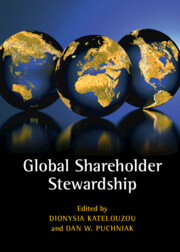Book contents
- Endorsements
- Global Shareholder Stewardship
- Global Shareholder Stewardship
- Copyright page
- Dedication
- Contents
- Figures
- Tables
- Contributors
- Foreword
- Acknowledgements
- Abbreviations
- Part I Foundations
- Part II Jurisdictions
- Part III Comparisons
- 25 Investment Management, Stewardship and Corporate Governance Roles
- 26 Sustainable Finance and Stewardship
- 27 Shareholder Stewardship Enforcement
- 28 Can a Global Legal Misfit Be Fixed?
- 29 Shareholder Stewardship in Asia
- 30 The Global Diffusion of Stewardship Codes
- Index
27 - Shareholder Stewardship Enforcement
from Part III - Comparisons
Published online by Cambridge University Press: 28 April 2022
- Endorsements
- Global Shareholder Stewardship
- Global Shareholder Stewardship
- Copyright page
- Dedication
- Contents
- Figures
- Tables
- Contributors
- Foreword
- Acknowledgements
- Abbreviations
- Part I Foundations
- Part II Jurisdictions
- Part III Comparisons
- 25 Investment Management, Stewardship and Corporate Governance Roles
- 26 Sustainable Finance and Stewardship
- 27 Shareholder Stewardship Enforcement
- 28 Can a Global Legal Misfit Be Fixed?
- 29 Shareholder Stewardship in Asia
- 30 The Global Diffusion of Stewardship Codes
- Index
Summary
In this Chapter, we investigate the availability (or not) of strategies to enforce shareholder stewardship and set out a simple enforcement taxonomy based on three dimensions: the nature of the norm enforcer (self-enforcement/third-party enforcement); the nature of the enforcement mechanism (formal/informal) and the temporal dimension of enforcement (ex-ante/ex-post). We examine the enforcement of shareholder stewardship across 25 jurisdictions and find that informal enforcement by market actors is the preferred option. Looking forward, we sketch the broad contours of an optimal stewardship enforcement framework based on our taxonomy. We caution against administrative sanctions and support instead a facilitating role for (quasi-)public in two ways. First, (quasi-)public actors can facilitate stewardship enforcement via membership/adherence sanctions taking place within stewardship networks (e.g. public tiering) or informal mechanisms (e.g. reputational mechanisms and private dialogue). Secondly, where ultimate investors have suffered damages from deficient stewardship disclosure, we support the introduction of a facilitating system of civil claims that can serve both restorative-compensatory objectives and public interests. We also advance the importance of promoting enforcement by market and social actors. Our enforcement framework is not intended to be applied in a uniform fashion around the world. Rather its multi-actor, multi-modal and temporally continuous fashion can adjust to any national or supranational framework.
Keywords
- Type
- Chapter
- Information
- Global Shareholder Stewardship , pp. 572 - 598Publisher: Cambridge University PressPrint publication year: 2022
- 1
- Cited by



